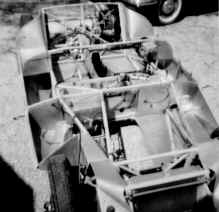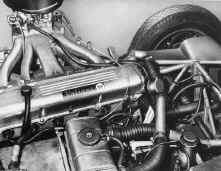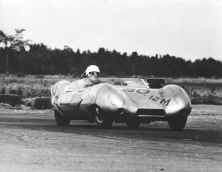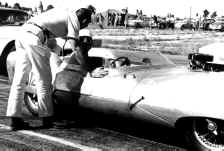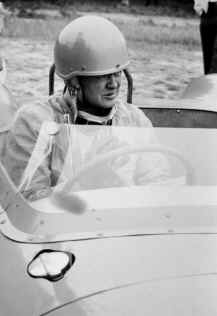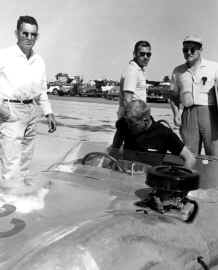| the LOTUS-VALIANT | |
|
notes from two of its creators, George Wallace and Russ Shreve |
|
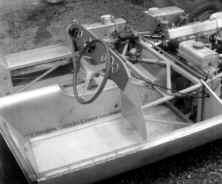
|
from George Wallace: The OPEN EXHAUST article was written by Floyd Lawrence, who had been SCCA Regional Executive and was Detroit editor for Steel Magazine. In 1961 our sponsor took the car back and sent it to a partner of his, a Plymouth dealer in Phoenix. His name was Bob Montana I believe. After that we lost touch with the car. In 1980 a man I was working with made a concerted effort to trace the car. He talked to various people in Phoenix and one person told him that the car was either crashed or scrapped and no longer existed. Since there has been no sign of it in 40 years, that is probably true. We had modified the frame to the extent that it would never pass for a standard XI. |
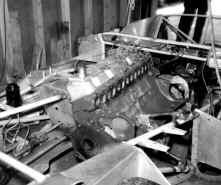
|
I am a long time admirer of ColinChapman, who I think contributed more to race car design in the second half of the century than anyone else. I had the good fortune to meet him twice. In the fall of 1960 four of the five Lotus Valiant builders had lunch with him in Detroit and explained the car to him. Chapman was interested in what we had done. He only saw pictures, as there was no time to see the car. The lunch was set up by John Posselius, the midwest Lotus distributor. The other occasion was the Monday or Tuesday night after the 1962 USGP at Watkins Glen. John Posselius mentioned to Russ Shreve that Colin and Jimmy Clark were spending the night with him, and we might want to drop in unexpectedly. We did so and Colin mentioned that they were going to Indianapolis the next day with the Lotus 25 to see how it would run. He said nothing at that time about the Ford program, but that run was really the start of the complete revolution at Indianapolis and brought that race up to the rest of the world in car design. |
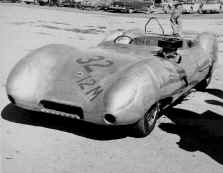
|
from Russ Shreve: The next step from LotusValiant was the Ford Indy Lotus. When Colin got the job of building the car he could not figure out how to get the upper frame tubes past the V-8 engine back to support the rear suspension. He asked me how I had made the LotusValiant work. Colin had tried the engine as part of the structure in one of his early trials cars. It was a handling disaster. Colin wanted to make the Ford engine part of the Indy car structure, but his past experience with the trials car told him it was not that simple. I told him the first part of the answer was quite simple; If you want the engine to be a part of the structure it has to be rigid. Just because you have a big chunk of cast iron or aluminum does not mean it is rigid. In fact, many of the older engines were deceivingly flexible compared to their appearance. The Valiant slant-six engine was one of the first to be designed to be rigid in torsion. Working with Chrysler I had access to the test rigidity numbers. The second part of the answer is a bit more complex. How rigid must the engine be to give adequate rigidity to the chassis. I worked out an empirical equation based on the desired handling qualities and use of the vehicle. To have immediate and precise handling a race car would require rigidity numbers based on certain suspension factors, but a passenger car could get by with somewhat less. It was this knowledge that Colin used to determine what rigidity would be required in the Ford block to support rear suspension loads, and provide race car handling. Colin gets the credit for starting the engine-as- part-of-the-chassis revolution. But he learned how to do it from the LotusValaint. In the photos (at left) Trant Jarman is the driver. In the group photo the person getting in the car is Jarman. The person to the far right behind the car with the hat is George Wallace. To his right, and just behind Jarman is myself. The person to the left of the photo is the son of Gene Casarol, our sponsor. Gene sponsored several cars at Indy. He is most known for being the head of Dual-Ghia, the car of choice for Sinatra and the Rat Pack. I think the photo was taken at Goderich, Ontario, Canada Trant Jarman died some years ago. He and I were actual co-owners of the car. From what I understand Dave Long is in California. Although I did the design work, and made the engineering drawings, Dave made the special parts work. Dave was very good with materials and processes, and an incredible craftsman. He later built a Chrysler powered car that was a work of art. The last I heard of Chris Kennedy he was retired and living in Maine. And of course, George was the performance Guru. The performance charts are all by George. Whenever we went racing the gearing setup had been worked out by George in his early computer program that modeled the tracks we ran. Remember, this was 40 years ago, and George is one of just a few folks at the time that could do that sort of thing. It worked quite well, except at one track...but that's another story . . . . |
photos courtesy of Russ Shreve |
from George Wallace: In my performance curves there are three plots labeled "Activity Factor". This odd term is what we called calculated acceleration at Chrysler. I'm not really sure why, it was used before I got there in 1953. Activity Factor is acceleration and the units are ft/sec/sec. There are three acceleration curves for the three different axle ratios, 3.23:1, 3.55:1 and 3.91:1. The speed vs. time and distance vs. time curves are self explanatory. The plot labeled Valiant Power is the actual power
and torque curve for the particular engine that went in the car. The
other power curve, "Valiant In the 60's I think that Chrysler did have the most productive engineering group in Detroit. We had a total of 4,500-5,000 people in Engineering. GM probably had 20,000+ with all of their divisions. We had to be smarter and get things right the first time because we couldn't afford to do it again if it wasn't right. |
